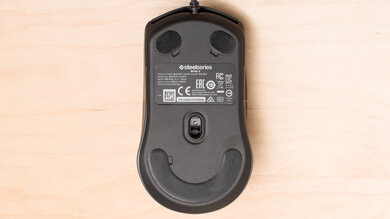The SteelSeries Rival 3 is a great wired gaming mouse. It feels very comfortable to hold, and any hand size can easily reach all the buttons using a claw grip. The mouse is very lightweight, and its software is fully compatible with both Windows and macOS. Unfortunately, the side buttons start flush with the body of the mouse, which makes them slightly difficult to press unless your thumb rests in just the right spot.
Our Verdict
The SteelSeries Rival 3 is a decent mouse for office or multimedia use. While its straight design may not be as comfortable for extended periods as a slanted more ergonomic mouse, it's comfortable enough to reach all the buttons. It's recommended for a claw grip, and it'll be well-suited for any hand size with this grip type. Unfortunately, there's no horizontal wheel or L/R tilt buttons on the mouse wheel, which may be a deal-breaker if you have to scroll horizontally through long documents like spreadsheets.
-
Excellent sensor performance with low CPI variation.
-
Comfortable for all hand sizes with claw grip.
-
Side buttons can be a bit difficult to press.
-
Low profile scroll wheel may not be for everyone.
The SteelSeries Rival 3 is a great mouse for FPS games. The mouse is quite lightweight, and all of its buttons can be programmed, including the L/R clicks and up/down scrolls. The sensor performance is excellent, and it has very good click latency. Unfortunately, the side buttons can be a bit difficult to press, and the fairly recessed mouse wheel may not be for everyone. While small hands may have a tough time with fingertip grip, the shape is well-suited for a claw grip for all hand sizes.
-
Excellent sensor performance with low CPI variation.
-
Comfortable for all hand sizes with claw grip.
-
Side buttons can be a bit difficult to press.
The SteelSeries Rival 3 is a very good MMO mouse. While it doesn't have nearly as many programmable buttons as dedicated MMO mice, all of its buttons can be reprogrammed, which is good. It's quite comfortable for long periods, and while small hands may have a tough time with fingertip grip, all hand sizes will have no problems using a claw grip.
-
Excellent sensor performance with low CPI variation.
-
Comfortable for all hand sizes with claw grip.
-
Side buttons can be a bit difficult to press.
Like most wired gaming mice, the SteelSeries Rival 3 is disappointing for travel. The mouse itself is fairly large and its wire may be cumbersome in tight spaces like on a plane or train.
-
Comfortable for all hand sizes with claw grip.
-
Side buttons can be a bit difficult to press.
-
Low profile scroll wheel may not be for everyone.
- 6.3 Office/Multimedia
- 8.3 Video Games (FPS)
- 7.8 Video Games (MMO)
- 5.6 Travel
Changelog
- Updated Sep 08, 2022: We've converted this review to Test Bench 1.3. This update adds a new Sensor Latency test and makes minor changes to several of our existing tests, resulting in test result changes in several sections. For more information, you can check out our full changelog here.
- Updated Aug 15, 2022: We've converted this review to Test Bench 1.2. This update simplifies our Weight test and expands on our CPI test from Test Bench 1.1, resulting in changes to test results in both sections. For more details, you can see our complete changelog here.
- Updated Jun 22, 2022: We've updated this review to Test Bench 1.1, which revamped our click latency test methodology. We've updated the text to reflect our new results in various sections, including the Click Latency test box, Usages, Introduction, and other locations where we discuss click latency.
- Updated May 30, 2022: We've converted this review to Test Bench 1.1. This update revamps our Click Latency test and results in changes to test results. For more details, you can see our full changelog here.
- Updated Jun 22, 2021: Updated 'Build Quality' photo to have RGB lights turned on for consistency.
Check Price
Compared To Other Mice
The SteelSeries Rival 3 is a great wired gaming mouse available at a low price point. While it doesn't have as high of a max CPI as some more expensive gaming mice, it's still higher than most gamers require. It's great for all hand sizes when used with a claw grip.
See our recommendations for the best gaming mouse, the best wired gaming mouse, and the best mouse.
The SteelSeries Rival 3 is overall a better gaming mouse than the Razer DeathAdder Essential. The SteelSeries has a sturdier-feeling build, a lighter weight, smoother-gliding mouse feet, and onboard memory. It also has lower latency, a wider CPI range, and a more consistent sensor. Comparatively, you can set a HyperShift button on the Razer, giving you a second layer of controls for as long as you hold it. Also, the Razer's larger size and shape make it more suitable for larger hands using a palm grip.
The SteelSeries Rival 3 is much better than the Corsair HARPOON RGB. Both mice have a similar shape and are recommended for the same hand sizes and grip types, but the SteelSeries is an ambidextrous mouse. It also has a much more consistent sensor, and it has more programmable inputs. On the other hand, the Corsair has textured grips on the sides.
The SteelSeries Rival 3 Wireless and the SteelSeries Rival 3 look and perform very similarly. The Wireless is better for travel thanks to its wireless design and wireless connectivity options, and its minimum CPI is lower than the Rival 3. The Rival 3 is wired-only, it's lighter than the Wireless, and its click latency is slightly better.
The SteelSeries Rival 3 and the Logitech G203 LIGHTSYNC are great wired gaming mice with comparable performance. The SteelSeries is lighter, has a marginally higher maximum CPI, has onboard memory for settings, and has quieter mouse clicks. The Logitech has much better click latency, a CPI that you can set more precisely, and a lower lift-off distance. If you have small hands and prefer using a fingertip grip, the Logitech will likely be more comfortable. If you use a claw grip but have extra-large hands, the SteelSeries may be more suitable because of its longer body. Both mice are only suitable for a palm grip for small or medium-sized hands.
The Logitech G502 HERO and the SteelSeries Rival 3 are two very different gaming mice. The Logitech is an aggressive-looking mouse with a wider grip, a thumb rest, and more buttons. It also has a much wider CPI range, a lower lift-off distance, and better click latency. On the other hand, the SteelSeries is much smaller and significantly lighter. It also has better feet, and it's fully compatible with both Windows and macOS.
The SteelSeries Rival 3 and the Logitech G203 Prodigy are both great wired gaming mice. While the SteelSeries is suitable for all hand sizes with claw grip and all sizes except for small with fingertip grip, the Logitech is good for all hand sizes with fingertip grip and all except extra-large with a claw grip. Both mice have similar max CPI, though you can adjust the Logitech by steps of 50, unlike the SteelSeries' 100. The SteelSeries' side buttons are lower profile, while the Logitech's buttons are slightly more pronounced.
The SteelSeries Sensei Ten and the SteelSeries Rival 3 are two similar mice, but the Rival 3 is a tad bit better. The Sensei Ten suffers from a somewhat slippery texture and is a bit heavier, making the Rival 3 a better option if you prefer lighter mice. Both come with the excellent SteelSeries Engine 3 software, which allows great performance and lighting customization.
The SteelSeries Rival 3 and the SteelSeries Aerox 3 (2022) are nearly identical in shape, but the Aerox has a honeycomb-cutout design and is lighter. Also, it has larger and better-quality mouse feet, and its braided cable is removable. On the other hand, the Rival has a solid body and feels much better built, and it has a lower lift-off distance.
While both the Razer DeathAdder V2 and the SteelSeries Rival 3 are great wired gaming mice, the Razer is better. The Razer has a much better wire, a lower click latency, better feet, more programmable buttons, and a much wider and more adjustable CPI range. On the other hand, the Rival 3 is fully compatible with both Windows and macOS and is lighter. While the Rival 3 is best with a claw grip for all hand sizes, you can use the Razer with all hand sizes with a palm grip, and only those with small hands will likely have a difficult time with either claw or fingertip grips.
The SteelSeries Rival 100 is a much earlier predecessor of the SteelSeries Rival 3, and they share nearly identical shapes. Both mice are ideal for a claw grip for all hand sizes. They're also well-suited for a fingertip grip for all but small hands and suitable for a palm grip for small and medium-sized hands. However, the newer Rival 3 feels better-build, and it has a lighter weight, better mouse feet, a lower click latency, a wider CPI range, and a CPI that's more precisely adjustable.
The SteelSeries Rival 3 and the Razer DeathAdder Elite are comparable wired gaming mice, and each has its advantages and disadvantages. The SteelSeries is significantly lighter, has a somewhat lower click latency, and its software is compatible with both Windows and macOS. It's suitable for all grip types, but it's ideal for a claw grip, regardless of hand size. On the other hand, the Razer has a wider CPI range, and you can set the CPI by increments of one. It also has a lower lift-off distance and larger side buttons. It's well-suited for a palm grip for all hand sizes, but those with smaller hands likely won't be able to use the mouse comfortably with a claw or fingertip grip.
The SteelSeries Rival 310 and the SteelSeries Rival 3 are both great wired FPS gaming mice. The Rival 3 is a bit lighter and has a more ambidextrous design that's best-suited for a claw grip. On the other hand, the Rival 310 has a slanted right-handed design that's better-suited for all hand sizes with a palm grip. The 310 also has a wider adjustable CPI range, but we measured a slightly lower CPI variation with the Rival 3.
The SteelSeries Rival 3 and the HyperX Pulsefire FPS Pro are both wired gaming mice, but the SteelSeries performs better overall. The SteelSeries has a lighter weight, a sturdier feel, smoother-gliding mouse feet, and more programmable buttons. Unfortunately, due to its lower profile, it isn't an ideal option for palm grip users with larger hands. On the other hand, the HyperX has a wider CPI range, a more precisely adjustable CPI, and a lower click latency. Its higher profile is also better suited for larger hands using a palm grip than the SteelSeries is.
The SteelSeries Rival 3 is a better wired gaming mouse than the HyperX Pulsefire Core. The SteelSeries is significantly lighter and has mouse feet that glide more smoothly. It also has a higher maximum CPI, a more consistent sensor, a much lower click latency, and customization software for Windows and macOS. Comparatively, the HyperX has two buttons behind the scroll wheel, while the SteelSeries only has one. Unfortunately, the HyperX lacks customization software for macOS. Both mice are suitable for all grip types and nearly all hand sizes, but the SteelSeries accommodates more hand sizes using a palm grip.
The Razer Viper Mini is a better wired gaming mouse than the SteelSeries Rival 3. The Razer is lighter, feels better built, is more comfortable, has a better cable, and has lower click latency. On the other hand, the SteelSeries' software is compatible with both Windows and macOS, and the mouse is better suited for claw grip for people with any hand size.
The SteelSeries Rival 3 and the SteelSeries Sensei 310 are great ambidextrous gaming mice. The Rival 3 is significantly lighter, has better mouse feet, a more consistent sensor, and newer software. On the other hand, the Sensei 310 has a wider CPI range and a pair of side buttons on either side. Both mice are ideal for a claw grip for all hand sizes and a palm grip for smaller hands. The Rival 3 is suitable for all but small hands using a fingertip grip, while the Sensei 310 is only suitable for large and extra-large hands using a fingertip grip.
The SteelSeries Rival 3 is a better wired gaming mouse than the Corsair HARPOON RGB PRO. The SteelSeries is lighter, its cable and mouse feet glide more smoothly, and it has better click latency. Comparatively, you may like the Corsair better if you'd prefer an ambidextrous shape. It also has a higher maximum CPI. Both mice are ideal for a claw grip for all hand sizes, a palm grip for smaller hands, and a fingertip grip for larger hands.
The SteelSeries Rival 3 and the Corsair KATAR PRO XT are great wired gaming mice with a similar ambidextrous shape. The Corsair's paracord-like cable feels more flexible than the SteelSeries's rubber cable, but its mouse feet don't glide as well. The Corsair has a more precisely adjustable CPI range and a much lower list-off distance, but its sensor isn't as consistent as the SteelSeries's.
The BenQ ZOWIE S2 and the SteelSeries Rival 3 are very similarly-shaped mice, but the SteelSeries is lighter and has access to software for customization options. The SteelSeries also has RGB lighting, and you can create multiple profiles and easily switch between them. You can also be a bit more precise with the CPI settings than with the BenQ, as it only has four presets.
The ASUS ROG Keris is a better, wired gaming mouse than the SteelSeries Rival 3. The ASUS is lighter and has a more flexible paracord-like cable. It also has a much wider CPI range and a lower click latency. On the other hand, the SteelSeries has hot-swappable left and right-click switches and customization software compatible with Windows and macOS, while the ASUS only has software compatible with Windows. Both mice are suitable for most hand sizes using all grip types.
The SteelSeries Rival 3 and the HyperX Pulsefire Surge are both wired gaming mice with ambidextrous shapes. The SteelSeries is much lighter, and it has smoother-gliding PTFE feet with no sharp edges. It also has a lower click latency, a more consistent sensor, and, unlike the HyperX, its customization software is compatible with macOS. On the other hand, the HyperX has a wider CPI range, a CPI that you can adjust more precisely, and a lower lift-off distance. Also, it's better suited for large hands when used with a palm grip.
The SteelSeries Rival 3 and the GLORIOUS Model D are both good wired gaming mice. The GLORIOUS is a bit lighter and is better suited for a palm grip, which the SteelSeries is better suited for a claw grip. The GLORIOUS has a much nicer cable, a slightly lower click latency, and a higher max CPI. On the other hand, the SteelSeries has more programmable buttons, and its software can be installed on both Windows and macOS.
The SteelSeries Rival 3 is a better, wired gaming mouse than the Redragon M601 RGB Centrophorus. The SteelSeries feels sturdier, has a more flexible cable, and has mouse feet that glide more smoothly. Performance-wise you can adjust the CPI by increments of 100 within a slightly wider range, and it has significantly lower click latency. Its customization software is compatible with Windows and macOS, while the Redragon's software is compatible with Windows only. On the other hand, the Redragon has a set of weights you can add to adjust the weight distribution, which the Razer lacks.
The SteelSeries Rival 3 is a slightly better wired gaming mouse than the Anker Gaming Mouse. The Rival 3 is a bit lighter, better suited for people with small hands, has a lower click latency, and has a much more consistent CPI. On the other hand, the Anker is still a great gaming mouse that offers fantastic value overall.
Test Results
The SteelSeries Rival 3 has a straight-forward looking ambidextrous design with two buttons on the left side. It has RGB lighting in a strip around the bottom of the mouse, as well as on the logo on the back. The entire mouse is black and has a low profile mouse wheel and buttons. If you don't like RGB lighting, check the BenQ Zowie S2.
Like most wired gaming mice, the SteelSeries Rival 3 isn't the most portable. Its fairly tall shape may be tough to slide into smaller laptop cases, and the cable may be cumbersome in tight places, like on a plane. However, this is fairly standard with gaming mice as it'll likely stay at home with your gaming setup.
The SteelSeries Rival 3 is quite light, especially if you use a bungee to remove the weight of the cable. Unfortunately, there aren't any weight optimization options. If you prefer an even lighter mouse with honeycomb-patterned holes, check out the ROCCAT Burst Pro. If you like the Rival 3 shape but prefer a honeycomb-cutout mouse, check out the SteelSeries Aerox 3 (2022).
The SteelSeries Rival 3 is very comfortable to use. While it doesn't have a slanted, ergonomic shape like some other options, its symmetrical shape is well-suited for claw and fingertip grips. The mouse has a fairly low profile overall, but with a higher bumped back. If you prefer a mouse with textured grips on the side, then look into the Corsair HARPOON RGB. Or, if you're looking for a similar wired gaming mouse with a selection of modular pieces available to adjust the look and feel of your mouse, check out the Pwnage Ultra Custom Ergo. If you're looking for a mouse with a true ambidextrous design and a pair of buttons on both sides, check out the EVGA X12.
The SteelSeries Rival 3 isn't designed for palm grip, but people with small or medium-sized hands should still be able to use it with this grip. While it's too small for very large hands, people with large hands may be able to comfortably grip it, but likely will also find it too small. If you have large or very large hands, check out the SteelSeries Sensei Ten.
This mouse is good with fingertip grip, though people with smaller hands may have a hard time comfortably reaching the scroll wheel. For a gaming mouse with comparable performance that's suitable for all hand sizes using a fingertip grip, check out the Logitech G203 LIGHTSYNC.
The SteelSeries Rival 3 is a wired-only mouse. If you'd like a wireless option, check out the SteelSeries Rival 3 Wireless or the SteelSeries Prime Wireless.
The cable on this mouse is the same as all other SteelSeries mice. It's a good quality rubber cable, but still maintains a few kinks from packaging.
The SteelSeries Rival 3 has two additional side buttons, giving it a total of eight programmable buttons, including the up/down scroll. The side buttons start flush with the body and raise slightly in the middle. This makes them a bit difficult to press unless your thumb rests on them just right, and even then, the buttons are quite stiff. If you want a SteelSeries mouse with more programmable buttons, check out the SteelSeries Rival 500.
The SteelSeries Rival 3 has very good click latency. There's some minor inconsistency. However, this slight variation doesn't cause any noticeable difference in-game, and the experience is responsive for gaming in any genre.
The SteelSeries Rival 3 has a fairly wide CPI range that can be adjusted in increments of 100. While the maximum CPI isn't as high as some other gaming options, it should be high enough for most gamers. You can choose between four polling rates: 125Hz, 250Hz, 500Hz, and 1000Hz. If you want a similar mouse with a CPI that can be adjusted more precisely, check out the Corsair KATAR PRO XT. For a lower lift-off distance and wider CPI range, check out the HyperX Pulsefire Surge.
The mouse wheel is decent. It doesn't have L/T tilt buttons or any horizontal scroll. The scroll itself has very soft increments and is quiet. The wheel has a very low profile and doesn't stick up far above the buttons, which makes it a bit more difficult to scroll, but easier to press for the middle click.
SteelSeries Engine 3 is an exceptional piece of software when paired with this mouse. It can be installed on either Windows or macOS, and you can customize every aspect of the mouse. This mouse also features on-board memory so you can save your customization options to the mouse and maintain them when switching computers. Unfortunately, while all keybindings retain when switching computers, macros cannot be saved to the on-board memory (though single key bindings can). For a mouse that has an OLED screen on the underside that you can use to change sensor settings without using software, check out the SteelSeries Prime+.
Comments
SteelSeries Rival 3: Main Discussion
Let us know why you want us to review the product here, or encourage others to vote for this product.
Update: We’ve converted this review to Test Bench 1.8, which updates our target curve and Sound tests. You can read more about this in our changelog.
- 21010
The “Weighted Harmonic Distortion” is significantly worse with 7.9 than the previous model’s 8.5. Indeed having just looked at that rating, I was looking for headphones which might be better, when I came across the older Sundara with a pretty good rating. It’s hard to figure out the significance of that “Weighted Harmonic Distortion” with the explanation, but I’ve asked AI (there you go) that it can be related to tone or timbre, and that’s arguably where one can find a weakness of the Sundara (particularly tone). (I did have a Sundara before, but it sort of got lost, without getting more into it.)
Edited 1 year ago: nothing important Update: We’ve converted this review to Test Bench 1.8, which updates our target curve and Sound tests. You can read more about this in our changelog.
- 21010
The “Weighted Harmonic Distortion” is significantly worse with 7.9 than the previous model’s 8.5. Indeed having just looked at that rating, I was looking for headphones which might be better, when I came across the older Sundara with a pretty good rating. It’s hard to figure out the significance of that “Weighted Harmonic Distortion” with the explanation, but I’ve asked AI (there you go) that it can be related to tone or timbre, and that’s arguably where one can find a weakness of the Sundara (particularly tone). (I did have a Sundara before, but it sort of got lost, without getting more into it.)
Edited 1 year ago: nothing important

































